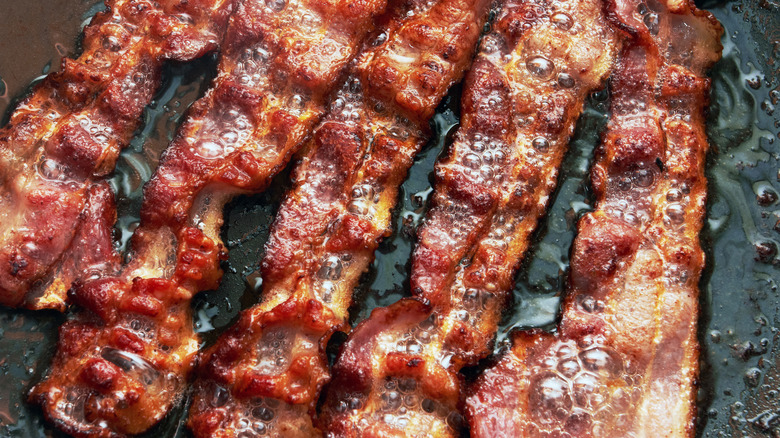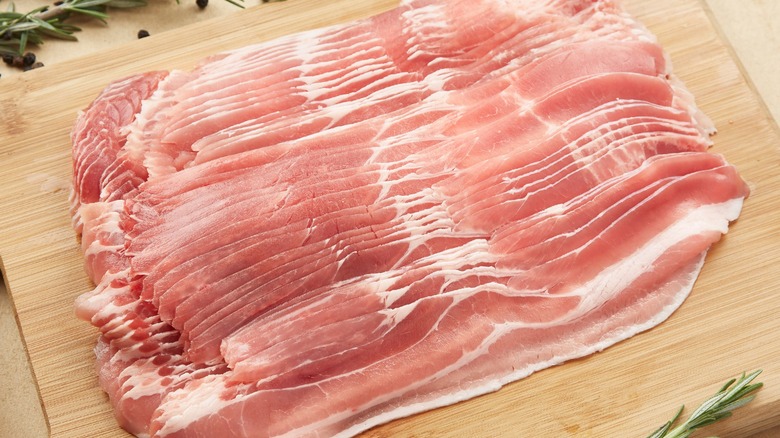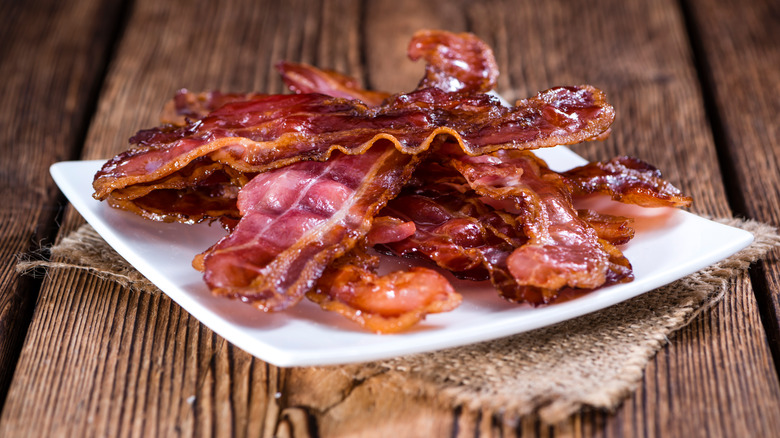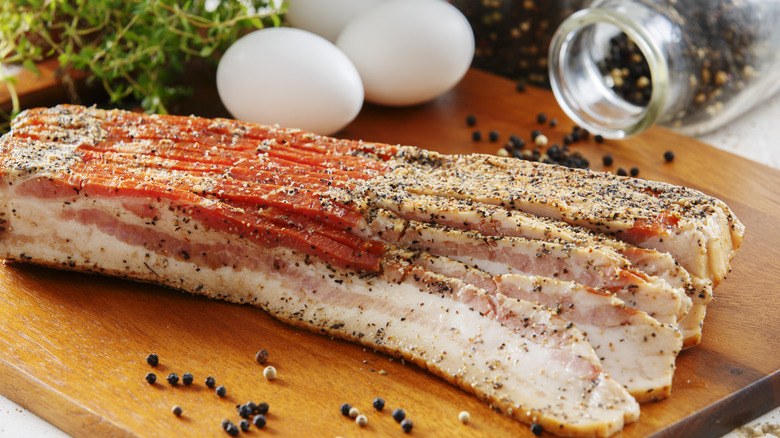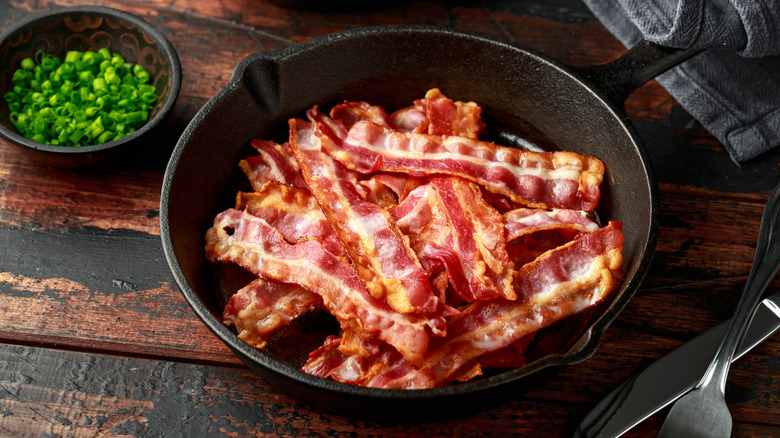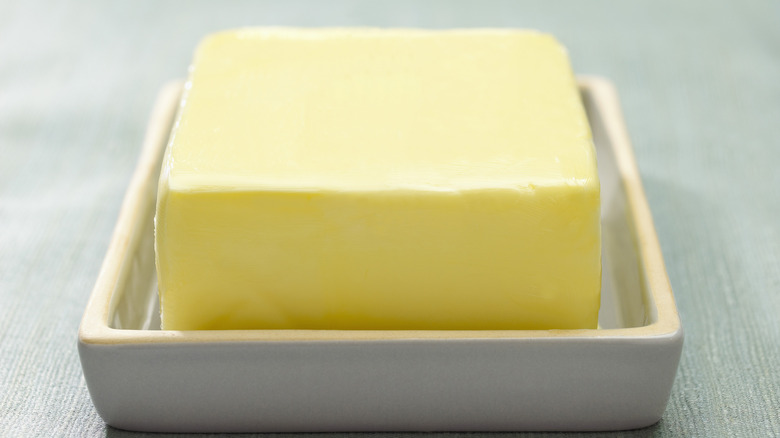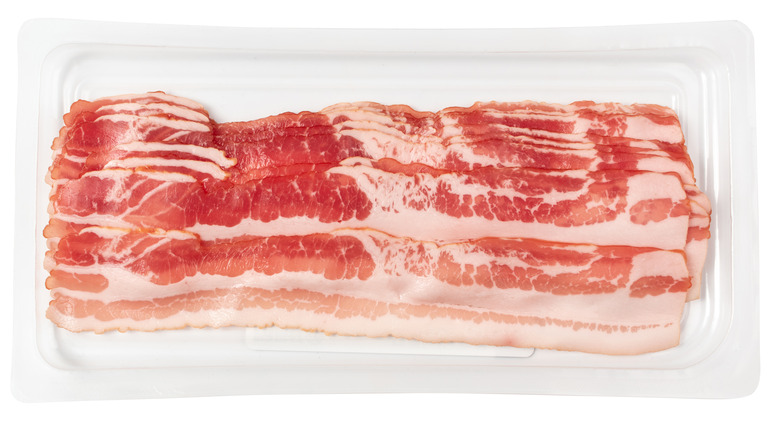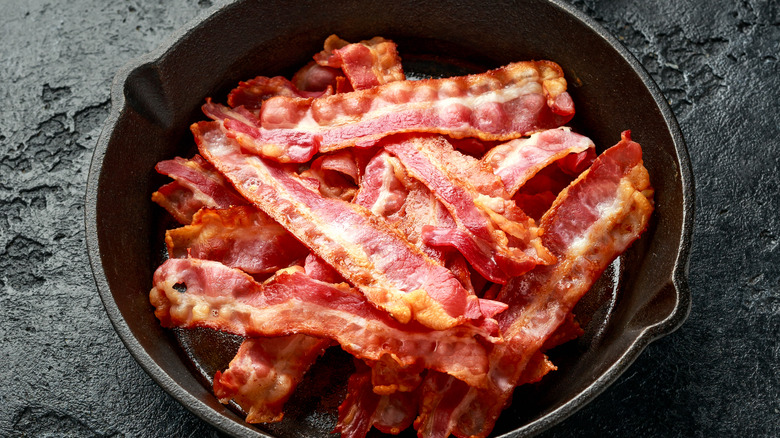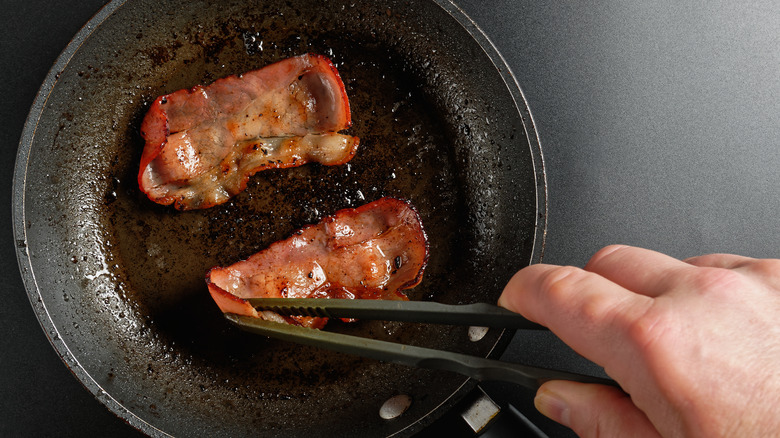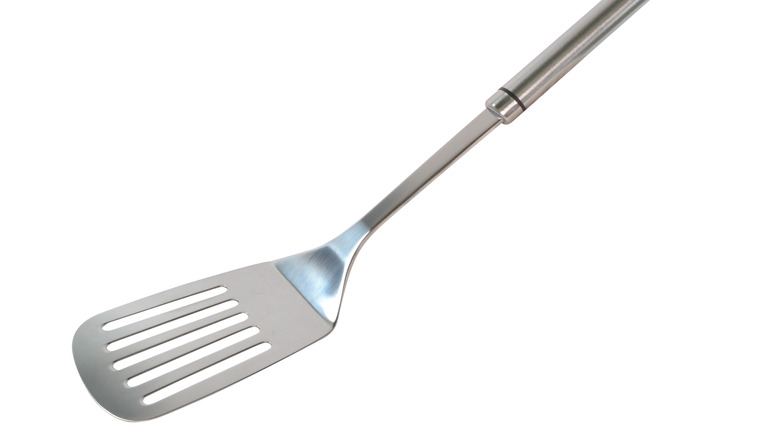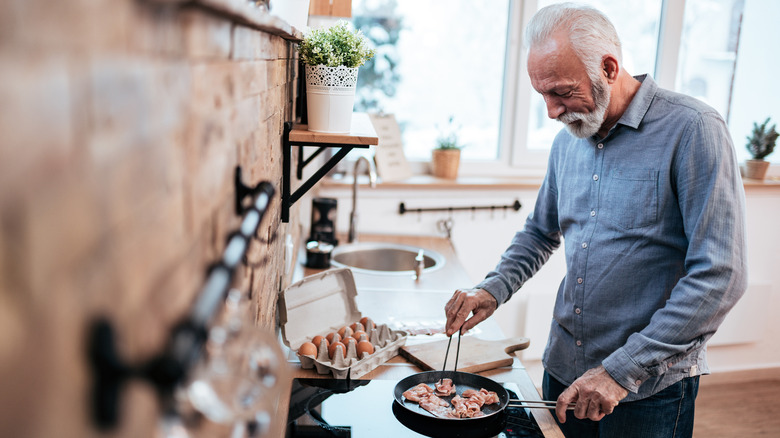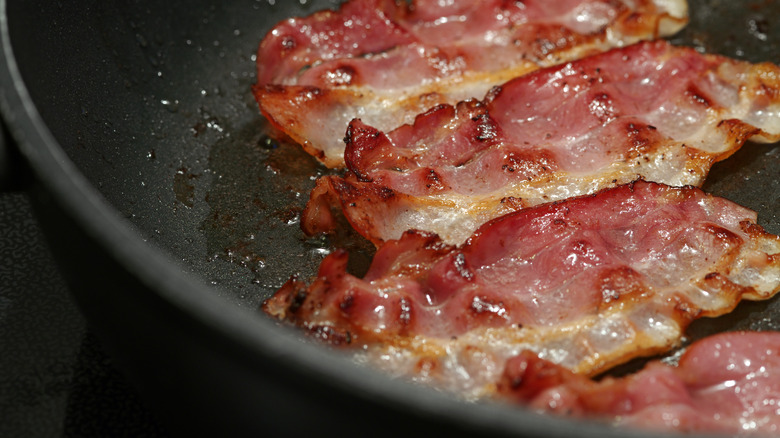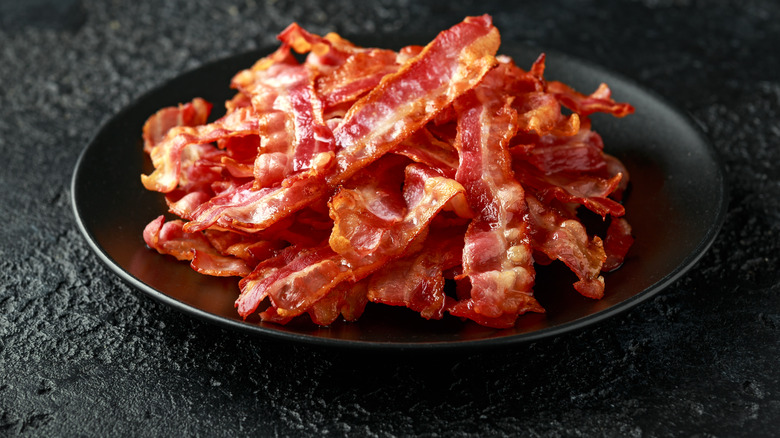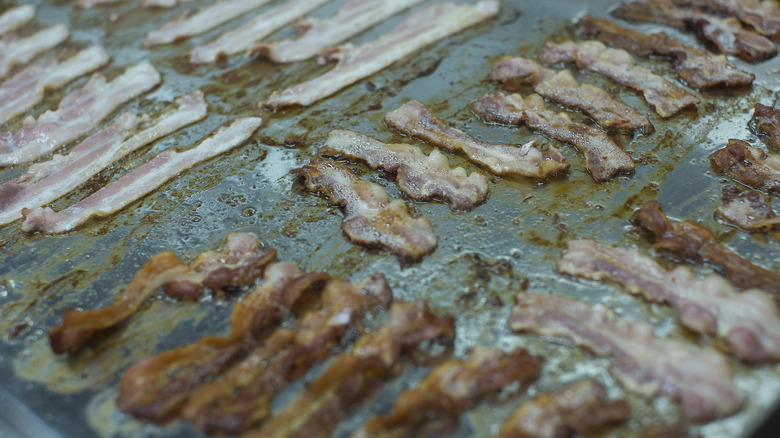13 Tips You Need To Cook The Absolute Best Bacon
Since the childhood days of waking up on the weekend, pouring an oversized bowl of cereal, and plopping down in front of the television, there have always been commercials stating just how important it is to have a balanced breakfast. The camera pans over the fruity bowl of cereal, a glass of orange juice, eggs, and a plate of steaming bacon. And for anyone in search of the ultimate balance of salt and fat and crisp and finger-licking, it comes down to that all-important bacon.
Is there anything better than waking up to the smell of cooking bacon and the way the buttery, salty aroma twists through the air and tugs you out of bed? Homeowners often bake cookies before showing off their homes to buyers. If they really wanted to sell the house quickly, they'd cook bacon instead.
Whether for yourself or for a sleeping family, what is the best way to cook bacon? There are many ways to do this, and there are even more contraptions sold to aid in your quest to cook bacon. While we don't suggest the Michael Scott method of sliding strips onto a George Foreman next to your bedside, we do recommend another means of preparing crispy bacon. This method is tried and true, and goes to show sometimes the best way to cook is also one of the oldest.
Picking the right cut of bacon
Picking out the right bacon isn't as simple as stopping by the bacon section of your grocery store and choosing one with a good price point. There are different brands, types, and cuts to go with. For this article, we're focusing specifically on pork bacon.
Different cuts of bacon come from different parts of the pig, and, in terms of which cut is right for you, it really comes down to how much fat you want on the strips. Fat on the bacon is necessary to help it cook (which is why lean turkey bacon tends to stick to just about anything), but if you're watching your weight, looking to cut calories, or just don't enjoy the chewier side of fatty bacon, keep these different cuts in mind.
There are various forms of bacon around the world, with regional favorites in nearly every pork-eating country. For classic American strips of bacon, it is best to focus on three specific cubs: streaky, regular, and center cut.
Streaky bacon is also known as side bacon and is one of the most popular cuts of bacon out there. However, it is also extremely fatty, which means you're getting less protein and more fat per slice. Due to this, in terms of quality bacon with more actual meat per strip, we recommend going with regular bacon and center-cut bacon. Both of these strips will result in crispy, salty, mouth-watering bacon.
The difference between regular cut and center cut bacon
There is a slight difference between the regular-cut and the center-cut bacon, although they are similar. The main difference is noticeable if you directly compare the two side by side. Regular bacon has fatty edges, while these fatty edges are removed on center-cut bacon.
The removal of these fatty edges does remove anywhere from 25% to 30% of the fat from each strip. Bacon manufacturing leader Hormel advertises its center-cut bacon as containing 25% less fat than its regular bacon. So, if you are looking for bacon with less fat, but still want to enjoy pork bacon instead of turkey (because let's face it, turkey bacon is fine, but there's just no replacing pork bacon), center cut is the way to go.
One thing to keep in mind is fattier bacon has less of a chance of sticking to the cooking surface. As fat heats, it starts to break down, providing a rendered, liquid barrier between the protein and the hot pan.
Choosing your bacon's thickness
In terms of cooking the perfect slice of bacon, the thickness is all preference. Standard bacon is about ¹⁄₁₆ of an inch thick, while traditional thick-cut bacon is ⅛ of an inch thick. If you are purchasing your bacon directly from a butcher who cuts the bacon for you (lucky you) the thickness might vary ever so slightly, but don't worry, as it won't throw off your ability to cook delicious strips of this meat.
Thinner bacon has a slight edge when it comes to crispiness, but even thick-cut bacon will cook into crispy deliciousness. As we will discuss later, the cooking time is negligible, as well. Thick-cut bacon might take a minute or two longer to fully cook, but that is really the only difference between the two. Also, bacon that comes pre-seasoned (such as the thick-cut peppercorn bacon in the image) won't have an impact on how it cooks. It all comes down to your personal preference and what fully brings your taste buds alive.
Cast iron is the ultimate cooking surface
The cooking surface is where you step up your bacon cooking game. Not all surfaces are created equal. Yes, there are stainless steel and aluminum options out there, but nothing lets you cook with the flavors of previous batches of bacon like cast iron. Plus, cast iron is built to last. Well-taken care of cast iron will last not only your lifetime but the lifetime of your children, possibly the very individuals you're cooking bacon for.
These cooking surfaces are economical, the metal stays hot, and it absorbs some of the oil and flavor of previously prepared dishes.
Don't have a cast iron skillet at your disposal? Don't rush out to the local home goods store and spend big bucks on a cast iron skillet. In fact, if you know where to look, you can secure a solid cast iron skillet for cheap. We generally don't like buying these online, simply because shipping for such a heavy kitchen item can be expensive. Instead, stop by the camping section of your local grocery store. Here, you'll find all kinds of great cast iron skillets for far less than the "designer" options found in the kitchen section. These are also easily found at garage sales, Facebook Marketplace, and Goodwill.
No additional fat is needed for cooking
This is why bacon is one of the easiest meats to cook. As pork bacon already has a high amount of fat, no additional oil or butter is needed to cook the meat and prevent it from sticking to the pan. So even if you are using leaner cuts, you don't need to break out the stick of butter or dip it into that expensive jar of duck fat you've been saving.
Of course, if you plan on serving your bacon with any kind of toast, we do recommend pulling the butter out of the fridge ahead of time, because nobody likes spreading hard butter (although the science behind optimal butter temperatures is a different topic for a different article). By the time you're finished cooking your bacon, you'll instead be left with a pan full of pork drippings and dissolved fat. You can use this later for future cooking needs (more on this later).
Begin with room temperature bacon
Trust us, we love stocking up on bacon when it goes on sale and tossing it into the freezer. It's a great feeling knowing you have several pounds of bacon waiting to satisfy your taste buds, but you don't want to pull the bacon out of the freezer and toss it immediately onto the skillet. In fact, you don't want to immediately take it out of the fridge and cook it, either.
Letting your meat warm to room temperature allows for it to cook more evenly. It also doesn't force the meat to go from cold to hot too quickly.
While you'll need to plan ahead with frozen bacon, pulling it out of the fridge doesn't take long. We like to pull the bacon out of the refrigerator first thing, then go about making our morning cup of coffee. By the time it's made and we're sipping on some cold brew, that bacon will be ready for the skillet.
Start by cooking your bacon on a cold skillet
One of the biggest issues most people have when cooking bacon is sticking to the pan. Of all the meat cuts, bacon is almost designed to not stick thanks to its higher fat percentage. However, that's all for not if you don't give the bacon fat enough time to dissolve. Pork fat will begin to break down, leaving you with a nice, buttery-like surface to cook on. That doesn't happen, though, when you preheat your cooking surface.
Laying bacon strips onto a hot surface is like cooking potatoes on a dry skillet. You'll end up with everything sticking and burning, which is frustrating, and then it makes cleaning up once you're done cooking even more difficult.
So, lay your bacon strips onto a cold cast iron skillet.
Do be aware though that you might run into some issues if you have an induction stovetop. These appliances are great for quickly boiling water, but when the purpose is to start cold and have the temperature build slowly to allow the fat to render. If it heats too quickly the bacon is more likely to stick, regardless of what you do. According to Consumer Reports, while stainless steel and cast iron are fine options for cooking on induction (avoid using any kind of aluminum) the induction can heat the surface before the fat has even had time to break down.
Spacing out the bacon is important
Making sure your meat cooks evenly is the name of the game. You don't want to end up with a half-crispy, half-limp piece of bacon. You want that entire piece of bacon to be uniformly cooked, and to make sure everything cooks evenly you'll want to space your bacon out. Thankfully, bacon shrinks when it cooks, so you don't need much space in between your bacon strips, but do make sure you avoid overlapping and overcrowding your bacon.
As your bacon continues to cook, separating the pieces will become easier, thanks to the shrinkage that takes place during the cooking process. You might feel included to add additional strips of bacon as space is made available. However, it's best to hold off and pour out the excess grease in between batches, so don't add more bacon until all the current bacon has finished cooking. Just make sure to avoid overlapping the strips of bacon after flipping. All of your bacon should cook evenly and be ready for serving at about the same time.
A thin slotted spatula will help prevent sticking
When working with bacon, you have two utensils to keep on hand: tongs and a thin-slotted spatula. Tongs are good for flipping, but you'll want to use a thin slotted spatula to prevent sticking. Even if you cook your bacon on a cast iron skillet, start on a cold surface, and use room temperature bacon, there is still a slight chance of some sticking. The thin spatula allows you to slide the utensil under the bacon and break up the sticking without tearing the bacon.
Going at the bacon with tongs before you break away any sticking may result in ripping the bacon apart. Once you know the bacon is free from the pan you can then turn to the tongs, as these allow you to flip more pieces at once.
Also, don't worry about using stainless steel and other metal utensils on cast iron. Your grandmother might scold you for using metal on iron, but a well-seasoned cast iron skillet is incredibly scratch resistant and durable.
Cook it low and slow
When it comes to beautifully cooked pork, few heating methods are better than low and slow. Talk to any BBQ pit master and they will likely tell you they cook their pulled pork or baby back ribs the same way. Bacon is just a really quick version of the other delicious pork offerings.
With bacon, set your stove to medium-low heat. This will give your bacon fat enough time to render without overheating the pan, causing the protein to stick. Thanks to the thin nature of bacon, you don't need a ton of heat to fully cook the meat. Plus, because you're cooking bacon at a low temperature, there is less of a chance of grease splatter. With that said, you still want to be careful, especially when unsticking or flipping the bacon. This is also why a slotted spatula is best, as less grease will collect on the utensil, which helps prevent flicking around boiling grease.
Flipping your bacon isn't an exact science
Bacon is already thin, which means it's going to cook through quickly. So much of this depends on the cut of bacon you're using, what medium-low on your stovetop is, and how thick your cut is, that there's no exact science as to how often or when you should flip your bacon. There's also no magic number of how often you should flip the bacon. Just keep an eye on the meat and flip when needed (making sure to separate the bacon from the skillet with your spatula first).
When you do flip the bacon, place the strips in different locations on the pan. Do this because many stove tops don't cook evenly, and even some cast iron skillets aren't the exact same thickness throughout. This means some areas of the pan might cook faster or slower. Flipping the bacon and setting the strips down in a different direction or on a different part of the skillet helps account for this possibility.
Remove the bacon from heat
Probably the best thing about bacon is it doesn't take long to cook, which means when you're hungry, you can have crispy, hot, melt-in-your-mouth bacon ready and on your plate in less than 20 minutes.
This will depend on several factors, but you should be ready to remove the bacon strips from the heat in eight to 12 minutes. Have a paper towel-covered plate ready. This will help absorb excess grease and dry the bacon. After all, while you might be ready to chow down on your crispy treat, you don't want to reach down and grab something hot and greasy.
Do be careful when removing your cast iron skillet from heat. Unlike other cooking options, this handle will be just as hot as the rest of the pan. You can use a towel in a pinch, but we like either using a heat-resistant handle that slides over the iron, or a rubber grip that wraps around the handle.
Give the cast iron plenty of time to cool before you clean it. If you take your cast iron from the stove and put it into the water too quickly, you are liable to crack the metal due to the extreme and sudden temperature change (known as thermal shock). Instead, just remove it from heat, place it on a back burner, and give it time to cool down before addressing it.
Cooking more bacon
What happens if you want to cook more bacon? If that's the case, you have two options.
First, begin by pouring out the remaining bacon grease into a container. An empty tin can is a great item for holding spare grease. By no means should you pour the grease down your sink. While the grease is liquid now, it will eventually begin to congeal and solidify. This will gunk up not only the garbage disposal, but it will begin to collect inside your drain, sticking to food particles, and potentially leading to clogs (it will also begin to smell).
With your skillet free of grease, you can begin cooking your next batch of bacon. Ideally, you'll give your skillet some time to cool down; after all, it is best to cook on a cool surface. But maybe you have to feed the troops before sending them off to school, or you just really, really love bacon. In that case, take a baking sheet, cover it in parchment paper, evenly lay out the bacon, and slide it into the middle of a 400 F oven. According to The New York Times, in about 18 minutes, you will have a sheet full of crispy bacon.
Of course, if you can find a large cast iron bacon sheet, that is the best of both worlds. But, if you don't feel like going out and hunting down large cast iron cookware, baking sheets will work just fine.
